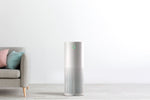Breathing Air Back into Our Schools and Offices

Posted by Dr. Mansour Abdulbaki, PhD, Director of Science & Education
Science-Based Guidance for Indoor Public Spaces
With all the discussions about re-opening schools and businesses during this routine-challenging pandemic, there are many sources of advice and opinions - not all bad, but not all complete. This guide is intended to give you the science-based considerations that you need to take into account when opening your spaces to employees, customers, and students.
Most guidance for public spaces focuses on cleaning surfaces to prevent transmission from high touch surfaces and social distancing “where possible.” While we’ll cover surface precautions here we’ll also go further and discuss best practices for how to handle the air we all breathe and focus on schools as a priority.
Acknowledging the importance of the school environment to whole-student development and the life-long consequences of being physically out of school, there are engineering actions that must be taken to provide safer spaces for reduced transmission among congregated and concentrated populations to transform schools into pandemic-resilient learning spaces.
Strategies to Reduce Transmission
Contact Transmission from Surfaces
The COVID-19 virus (SARS-CoV-2) falls into the “enveloped viruses” category. This category includes the common Influenza A virus and is one of the easiest classes of viruses to kill. This makes simply cleaning and disinfecting surfaces to reduce transmission of the virus an effective strategy. Cleaning and disinfecting surfaces should be done often and thoroughly and in accordance with CDC guidelines with EPA-approved cleaners.
Airborne Transmission
As mentioned, many cleaning strategies ignore the reason masks and social distancing are emphasized. The reason those things are so important is that a major mode of transmission is through the air.
A significant challenge with limiting the spread of this virus is that ~ 80% of people with COVID-19 have mild symptoms with many of those not even realizing that they are sick. When this happens, it is more difficult to identify cases and isolate individuals before transmission of the virus occurs - which is also made more difficult by the fact that the COVID-19 virus appears to be highest in the nose and throat soon after symptoms develop rather than later on when symptoms are more noticeable.
This is even more reason to ensure that environmental conditions are the best they can be to aid in reducing airborne transmission by people who may be asymptomatic or unaware of their infection.
As schools are a priority for their importance both in the social and academic development of students but also as a high volume gathering place of people who are not the most diligent with all our hygiene best practices, our examples will focus on this space. Schools inherently will have all of the conditions that increase risk: closed spaces, crowded places, and close conversations.
In any enclosed space, the best strategies for providing healthy air are to keep the air:
-
Exchanged
-
Diluted, and
-
Filtered
Air Exchange and Dilution
Ventilation provided by HVAC systems can reduce the airborne concentration of SARS‐CoV‐2 and the risk of transmission through the air. Outside air ventilation rates should be increased to as much as the building systems can accommodate.
- Building air systems should be operating at least 2 hours before & 2 hours after occupancy
- Increase outside air intake to increase dilution (lower the density) of indoor contaminants
- Maintain systems to ensure an exchange rate of 5+ room air changes per hour
The ability to maximize outside air intake is, of course, dependent on the outside climate conditions and the systems’ capacity to continue providing the desired indoor air temperature and humidity, and the sufficient airflow rates necessary to keep occupants comfortable and also provide good indoor air quality since these are all factors for a healthy environment. Data shows that relative humidity between 40% - 60% slows the transmission of viruses.

Air Filtration
If the climate does not allow for sufficient outside air dilution or the building systems do not provide the recommended air exchanges per hour, localized filtration is a fast and economical solution to providing a sufficient number of air changes per hour (ACH), which is defined as the number of times the equivalent volume of air in a room is turned over, either by exchange with outside air or passing through a filtration device.
The design standard for minimum ventilation in classrooms is approximately 3 ACH (ASHRAE 62.1 (2019)). However, the recommended ACH for reducing airborne contaminants is 5 or more. This would mean that the air in a classroom would be completely exchanged at least 5 times an hour, or once every twelve minutes. Greater than 5 complete air changes per hour offers more dilution but overall diminishing returns make any additional performance over 6 ACH less economical and not as impactful.
The figure below models the probability of infection from being in a room for 5 hours with between 1 and 4 infected persons and no masks, with varying levels of clean air changes per hour. Whether there were 1 or 4 infectors exhaling an average of 31 infectious particles (quanta) per hour, the increase is ACH from 2 ACH (which is slightly better than the 1.5 ACH average air exchange rate in schools based on studies) to 5 ACH reduced the probability of infection by ~45%. In a 200 square foot room with 8 foot ceilings, Jaspr Pro provides over 16 ACH without considering contributions from the HVAC system.

As a consideration, the airflow rate from existing building systems (dilution/filtration) and portable air purifiers equipped with HEPA filters are additive, so the ACH from each can be combined to provide improved air flow and circulation for occupants.
Building systems should have HVAC systems with MERV 13 filtration or better. While portable air purifiers should have HEPA filters which provide a minimum of 99.97% capture efficiency for all particle sizes with even higher performance for particles of diameters below 0.2 microns and greater than 0.5 microns.
The reality of getting people back to work and students back into classrooms for learning and socialization is impacted by the logistical considerations of the cost of improving or replacing existing HVAC systems and the time it would take to undertake such capital projects, especially as there is currently a dearth of supply.
Again, portable air purifiers with HEPA filters offer a quickly deployable, economical, and highly effective solution for reducing the risk of airborne virus transmission in classrooms and workspaces.
Use our guide to selecting air purifiers to understand what performance metrics and features are most important to helping you achieve safer indoor air quality.
Key Considerations
Purification Technology
▢ Does the unit have a certified HEPA filter?
EVERY single certified HEPA filter is tested 2-3 times each, depending on the certification standard, to ensure it meets the stringent performance required of HEPA certification : 99.97% capture efficiency or better.
▢ Avoid features that add cost without really being additive to performance.
The residence time of air through a purification unit is not long enough for UV technologies to have an effect on most passing microbes. AND if you have a HEPA filter, that filter is already capturing 99.97 - 100% of all particle sizes.
▢ Definitely avoid features that are ineffective and harmful
Ozone generators and electrostatic cleaners will not prevent re-distribution of harmful particles into the air and ozone in the breathing zone has been shown to be harmful at higher concentrations - so you don’t want to be generating this molecule that is the major component of smog in the closed spaces of your practice. Ozone belongs in the upper atmosphere, not in our classrooms and offices.
Cleaning Capacity and Placement
▢ Airflow: What are the CFM levels at different speeds?
Be sure that the units you are studying can move high volumes of air with their filters in place like they would be in use. The higher the cubic feet per minute (CFM) of air it can handle the more frequently you’ll get the room air changed over.
▢ What ACH will you get?
The CFM tells you what volume of air will be handled per minute, but what matters to your staff and students is the resultant air changes per hour (ACH) your room will experience. This will be based on room size - and configuration matters to get it exactly right, but for a good starting estimate a calculator for ACH can be found here.
▢ Placement and Flow Patterns
Consider how you will fit a unit into your space so that it will be able to function properly.
-
Air intake should not be occluded.
-
Place the HEPA unit near the center of the room, if possible.
Noise Level
▢ What is the noise level of the unit at its high and medium settings?
▢ How many CFM do you get at an acceptable noise level for all day operation?
Noise is an important factor to consider. If the unit is too loud and gets turned off, the cleaning efficiency is ZERO. Look for a unit with a noise level below 70 decibels at its fastest setting.
▢ Does the unit automatically detect air quality and adjust its speed to match?
Back to Blog



